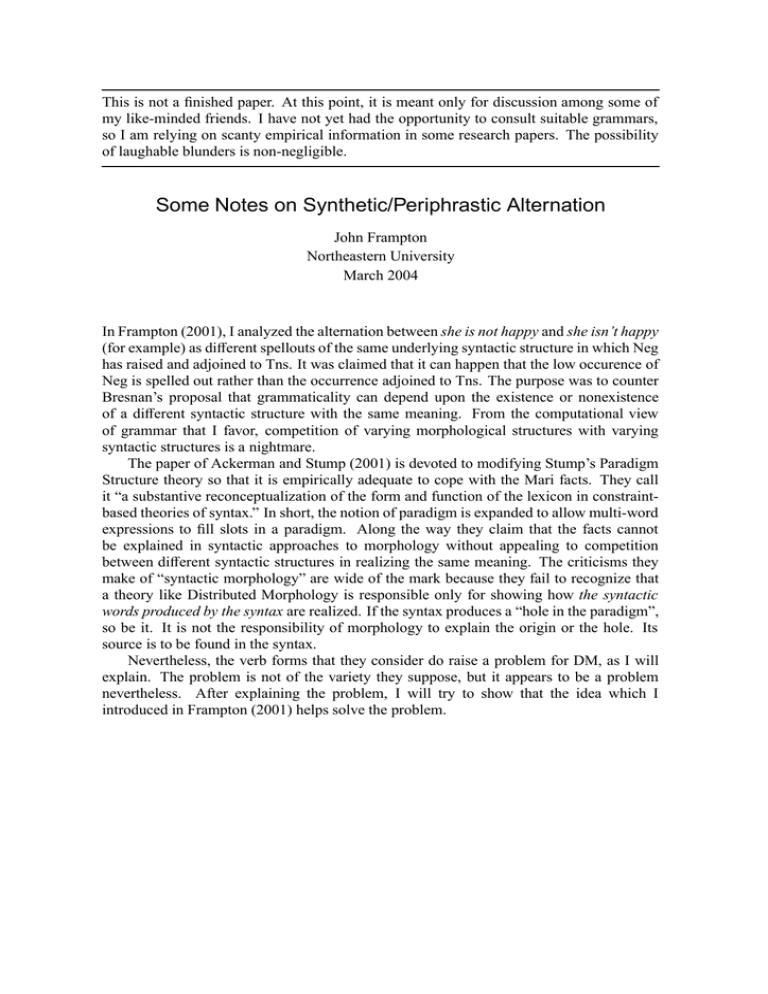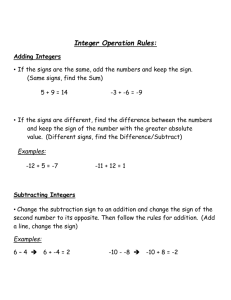Some Notes on Synthetic/Periphrastic Alternation
advertisement

This is not a finished paper. At this point, it is meant only for discussion among some of
my like-minded friends. I have not yet had the opportunity to consult suitable grammars,
so I am relying on scanty empirical information in some research papers. The possibility
of laughable blunders is non-negligible.
Some Notes on Synthetic/Periphrastic Alternation
John Frampton
Northeastern University
March 2004
In Frampton (2001), I analyzed the alternation between she is not happy and she isn’t happy
(for example) as different spellouts of the same underlying syntactic structure in which Neg
has raised and adjoined to Tns. It was claimed that it can happen that the low occurence of
Neg is spelled out rather than the occurrence adjoined to Tns. The purpose was to counter
Bresnan’s proposal that grammaticality can depend upon the existence or nonexistence
of a different syntactic structure with the same meaning. From the computational view
of grammar that I favor, competition of varying morphological structures with varying
syntactic structures is a nightmare.
The paper of Ackerman and Stump (2001) is devoted to modifying Stump’s Paradigm
Structure theory so that it is empirically adequate to cope with the Mari facts. They call
it “a substantive reconceptualization of the form and function of the lexicon in constraintbased theories of syntax.” In short, the notion of paradigm is expanded to allow multi-word
expressions to fill slots in a paradigm. Along the way they claim that the facts cannot
be explained in syntactic approaches to morphology without appealing to competition
between different syntactic structures in realizing the same meaning. The criticisms they
make of “syntactic morphology” are wide of the mark because they fail to recognize that
a theory like Distributed Morphology is responsible only for showing how the syntactic
words produced by the syntax are realized. If the syntax produces a “hole in the paradigm”,
so be it. It is not the responsibility of morphology to explain the origin or the hole. Its
source is to be found in the syntax.
Nevertheless, the verb forms that they consider do raise a problem for DM, as I will
explain. The problem is not of the variety they suppose, but it appears to be a problem
nevertheless. After explaining the problem, I will try to show that the idea which I
introduced in Frampton (2001) helps solve the problem.
2
1. Negative verbs in Uralic
There is usually fairly complex verb morphology in Uralic languages. The most
striking feature is that Uralic languages have special negative verbs that are used as
auxiliary verbs to negate other verbs. (Cf. Finnish en ota ‘I do not take’ to emme ota ‘we
do not take’. Note that e- is the stem of the negative verb, and the personal suffixes -n
and -mme are attached to it.)
Anatole Lyovin, An Introduction to the Languages of the World
The Uralic language Mari uses negative verbs in some tenses, but combines the main
verb and negation in a negatively inflected verb in other tenses. Various inflected form of
the verb root kol ‘die’ in the Western dialect of Mari are given below:
(1)
Affirmative forms
1
2
3
kolˆ@-š-ˆ@m
kolˆ@-š-ˆ@c
kolˆ@-š
1
2
3
kolˆ@-ne-m
kolˆ@-ne-t
kolˆ@-ne-ž@
1
2
3
singular
kol-en-äm
kol-en-ät
kol-en
Negative forms
First past
kolˆ@-š-na
š-@m kolˆ@
š-nä kolˆ@
kolˆ@-š-ta
š-@c kolˆ@
š-δä kolˆ@
koleB-@
@š kolˆ@
@š kolep
Present desiderative
kolˆ@-ne-nä
@-ne-m kolˆ@ @-ne-nä kolˆ@
kolˆ@-ne-δä
@-ne-t kolˆ@
@-ne-δä kolˆ@
kolˆ@-ne-št@
@-ne-ž@ kolˆ@ @-ne-št@ kolˆ@p
Second past
plural
singular
plural
kol-en-nä
kolˆ@-δe-l-am
kolê-δe-l-na
kol-en-dä
kolê-δe-l-at
kolê-δe-l-δa
kol-en-@t
kolê-δe
kolê-δe-l-ˆ@t
(According to Kangasmaa-Minn (1998:229), Ackerman and Stump’s source, “the first past refers especially
to states and events which the speaker has personally witnessed, which the second past is more or less a
record of what has been or happened without any emphasis on the speaker’s attitude towards the truth value
of the utterance.”)
Leaving aside a possible subject in Spec(V), it is plausible that the relevant syntactic
structure of affirmative clauses in Mari is:
(2)
Agr
Tns
V
3
Given this structure, the affirmative paradigms in (1) can be derived if standard Vraising is assumed.
(3)
Agr
t Tns
Agr Tns
tV
Tns
V
As expected, the tense suffix (-š, -ne, -en) appears between the verb and the agreement
marker. I use Tns liberally here to include whatever features are associated with the
desiderative.
It is also plausible that the structure of negative clauses is:
(4)
Agr
Tns
Neg
V
The negative second-past forms (2) can also be derived if standard V-raising is assumed.
(5)
Agr
t Tns
Agr Tns
t Neg
Tns Neg
Neg
tV
V
Note that the tense suffix appears to be missing from the negative inflected forms. DM has
no particular difficulty in accounting for this. It will turn out, however, that this fact is of
more significane than it might appear to be.
I will not go through the details, but DM has no difficulty in establish vocabulary items
so that the appropriate forms are produced for all the affirmative forms (i.e. those without
4
Neg) and the synthetic negative forms of the second-past. Now consider the periphrastic
negative forms, repeated below:
(6)
1
2
3
1
2
3
First past
š-@m kolˆ@
š-nä kolˆ@
š-@c kolˆ@
š-δä kolˆ@
@š kolˆ@
@š kolep
Present desiderative
@-ne-m kolˆ@
@-ne-nä kolˆ@
@-ne-t kolˆ@
@-ne-δä kolˆ@
@-ne-ž@ kolˆ@ @-ne-št@ kolˆ@p
If the verb form was kolˆ@ throughout, the periphastic negative forms could easily be
derived from a syntactic structure in which V does not raise to Neg.
(7)
Agr
t Tns
Agr Tns
t Neg
Tns Neg
V
How does morphology enforce the relation between the lexical realization of V and
Agr? V is realized as kolep in the 3pl, otherwise as kolˆ@. The account which I will
propose below will assume that, in fact, V raises all the way up to Agr in the syntax
in both affirmative and negative clauses, so that V is in the same syntactic word as Agr,
establishing the local context needed for context sensitive realization. I first review and
update the proposal in Frampton (2001).
2. Split spellout of head chains
The GB view of head raising was something like:
(8)
−→
X
Y
X
X Yj
tj
5
Under the Copy Theory of Movement, this changed to something like:
(9)
−→
X
Y
X
Yj
X Yj
It is generally the case that realization of the structure (9) maps the complex head (X
with Y adjoined to it) into a complex lexical item and the trace of Y is not spelled out.
Typically, X is realized as an affix (often a suffix) on the realization of Y, as illustrated in
(10a). X and Y are the realizations of X and Y. Frampton (2001) proposed that under
certain conditions it can happen that Y is realized in its lower position and X in the higher
position, as in (10b).
(10) a.
b.
X
X Yj
X
Yj
X Yj
X + Y
X
Yj
Y
The syntactic structure has hierarchical, but no linear structure. The output, the lower line
in (10), is linearly ordered. The mapping from the syntactic structure has the responsibility
not only of realizing the syntactic words, but of linearly ordering them.
In Frampton (2001), the alternation between she is not happy and she isn’t happy was
claimed to be of this kind. The viability of that particular analysis is not relevant here,
but it did introduce the idea that alternations between synthetic (isn’t) and periphrastic (is
not) forms could be different spellouts of a single underlying syntactic form. The purpose
was to counter Bresnan’s proposal that grammaticality can depend upon the existence or
nonexistence of a different syntactic structure with the same meaning.
There are two refinements of (10) that may as well be introduced at the start. First, the
“copy theory” should be replaced by what Chomsky calls the “occurrence theory”. In place
of (11a), the representation is (11b):
b.
(11) a.
X
X Yj
X
Yj
Y
X
The point of the idea of occurrences is that the two versions of Yj that appear in (11a) are
the same item. There is no point to allowing the notation to obscure what this means.
6
As an aside, it is worth noting that Brody writes the structure (11b) somewhat more
radically as:
(12)
X
Y
I would adopt Brody’s notation, but here I do not want the representations to look any
stranger than necessary.
The second refinement of (10) is to the output of linearization. Frampton (2002)
proposes that the linearization operation itself does not call on vocabulary insertion, but
maps to a prelexical representation to which vocabulary insertion applies. In place of (10a)
and (10b), we have:
b.
(13) a.
X
X
Y
X
Y⊕X
Y
X
X
Y
It is assumed that morphophonology then operates on forms like X 1 ⊕X2 ⊕. . . Xn cyclically,
from left to right. This is bottom-up conversion of the prelexical representation into
a morphophonological representation, using the lexicon to translate the feature bundles
encountered in the computation. There is one important qualification. The default case
has been illustrated in (13), so the feature bundles that the morphophonology sees are
identical to the feature bundles in syntax. Generally, however, the linearization mapping
can affect the feature bundles in various ways. This mapping is the locus for most (perhaps
all) impoverishment, for example. Frampton (2002) argues that impoverishment before
the lexicon is consulted considerably simplifies the task of lexical lookup and should
be preferred on these grounds even if it is not necessary for empirical adequacy. (This
is an interesting conflict between the desiderata of formal simplicity and computational
efficiency.) Importantly, linearization can sometimes make more dramatic changes in the
feature structure. Morphological features which play no role in the syntax can be added to
the feature bundles produced by linearization.
Note carefully that the linearization operations in (13) are not simply morphological
operations. Linearization determines the linear order of the realizations of the syntactic
words (i.e. complex heads) produced in by the syntax. It is the Spellout Operation which
plays a central role in modern syntactic theorizing—subject to whatever organization of
phrasal spellout proves to be correct.
7
Given this architectural framework, we are in a position to consider the phenomena
which prompted writing this note.
3. Split spellout in Mari
We return now to the kolˆ@/kolep variation in (6). Rather than (7), I will suppose that
the negative forms in all tenses have the structure in (14) and the synthetic/periphrastic
alternation is a spellout effect.
(14)
Agr
Tns
Agr
Neg
Tns
V
Neg
Suppose further that Western Mari is subject to:
(15) Verbs cannot be inflected for both tense and negativity.
This constraint appears to be widespread in the Uralic language group. There is some
ambiguity in (15). I take it to apply to the output of Linearization. One can imagine
various ways in which (15) can be satisfied.
One strategy is split spellout (i.e. periphrastic realization).
(16)
Agr
Tns
Agr
Neg
Tns
V
Neg
Neg ⊕ Tns ⊕ Agr
V
It seems that this is the general strategy followed in the Uralic languages.
Crucially, V and Agr are in a local structure in syntax, the same syntactic word. The
context is therefore available to locally differentiate between the form kolep which appears
in the 3pl and the elsewhere form kolˆ@. Suppose kolep is distiguished by some feature
8
F . Assume that linearization mapping adds the feature F to the bundle of morphological
features that V is mapped to in the context of 3pl. So we have:
(17)
3pl
Tns
3pl
Neg
Tns
V
Neg
Neg ⊕ Tns ⊕ 3pl
V ∪ {F }
3pl here is used as the name of a feature bundle, with no prejudice about how person
features are represented or what other features may be attached to Agr on the syntactic
side. Features other than person and number features (gender features, for example) are
deleted by Linearization.
Another strategy is deletion of the Tns. The synthetic negative second-past forms from
(6) are repeated below:
(18)
1
2
3
singular
kolˆ@-δe-l-am
kolê-δe-l-at
kolê-δe
plural
kolê-δe-l-na
kolê-δe-l-δa
kolê-δe-l-ˆ@t
The tense suffix -en is absent and in its position, between the negative suffix -δ and the
agreement suffix, an l appears. According to Ackerman and Stump:
The negative second-past realizations are built on a primary stem having two distinct
forms—an ABSOLUTE form identical to its negative gerundial stem (its root plust the
negative marker -δe and a CONJUNCT form arising from the absolute form through
suffixation of -l. The conjunct stem is used in the presence of inflectional suffixes and
the absolute form , in their absence; thus the latter form is restricted to the third-person
singular, since it alone is not overtly marked for subject agreement.
(p. 18)
9
Suppose that the conjunct suffix (whatever precisely it may be) is the exponent of some
feature Q and Linearization inserts Q when the tense features that offend (15) are deleted
from the Tns feature bundle.
(19)
Agr
Tns
Agr
Neg
Tns
V
Neg
V ⊕ Neg ⊕ {Q} ⊕ Agr
Perhaps one can argue that the conjunct marker -l is inserted only to keep the negative
suffix and the agreement suffix separated (for whatever reason). If 3sg agreement is deleted
by Linearization, there is no motivation for inserting the conjunct marker.
4. Top-down versus bottom-up spellout
It is clear that morphophonology processes the forms produced by Linearization in a
bottom-up (i.e. root first) cyclic fashion. Split spellout of heads is much more natural
if Linearization proceeds top-down, a non-standard view. See Frampton, Gutmann, and
Legate (forthcoming) for a development of this idea and its consequences (object shift,
etc.). I take the consequences for morphology to be an argument in its favor.
References:
Frampton, J. 2001. The amn’t gap, ineffability, and anomalous aren’t : Against morphosyntactic competition. CLS 37 (Panel Session).
Frampton, J. 2002. Syncretism, impoverishment, and the structure of person features. CLS
38 (Main Session).
Ackerman, F. and G. Stump. 2002. Paradigms and periphrastic expression: A study in
realization-based lexicalism. To appear.
My papers are available at http://www.math.neu.edu/ling/. The Ackerman and
Stump paper is available at http://ling.ucsd.edu/˜ackerman/maripaper.pdf.


